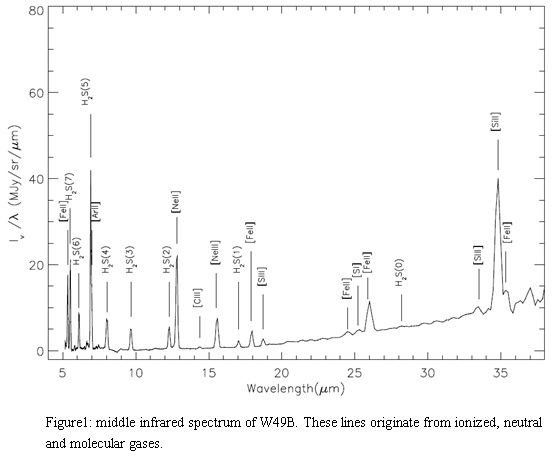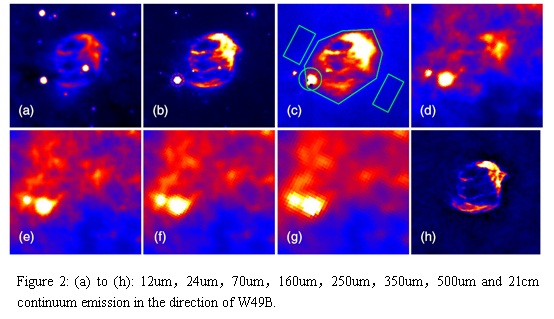NAOC researchers will publish their new result in the Astrophysical Journal (ApJ) on October 1st 2014: A detailed study of the environment of supernova remnant W49B (G43.3-0.2) by employing the survey data from Herschel Space Observatory, Spitzer Space observatory and Very Large Array observatory. Their research allows people to verify the position of W49B in the Milky Way and confirms the interaction between W49B and molecular clouds. They estimate the mass of the dust whose morphology is related to W49B and discuss the dust’s origin. The paper’s first author is Hui Zhu, a PhD student from NAOC. The authors include Dr. Wenwu Tian and Miss Pei Zuo. (Paper link: http://iopscience.iop.org/0004-637X/793/2/95/).
Stars with mass larger than 8M⊙ usually end their life through a core collapse supernova explosion. In most instances, the explosion is spherically symmetric with the ejecta and shock spreading evenly in all directions. However W49B seems to be an unusual case. X-ray observations show that the iron fades out in half the area of W49B and forms a bipolar jet-like structure. Considering the abundance of heavy elements in the ejecta, W49B was more likely born in a jet-driven aspherical explosion by a 25M⊙ progenitor. It is possibly the only supernova remnant in our Galaxy which has an Ib/c origin and could hold a black hole with age 1000-4000 years. Until now, our knowledge about W49B’s location and environment was poor and some previous results were even contradictory.
The authors reanalyze the absorption spectra of neutral hydrogen from W49B and compare its radio and infrared morphology with the distribution of the molecular cloud. They find that W49B is located in a wind-blown bubble surrounded by molecular clouds with a distance of 10 kiloparsecs. This result is consistent with the expectation for W49B’s progenitor. Furthermore, the authors check the middle infrared spectrum of W49B and identify pure rotational molecular hydrogen lines, H2 (0,0) S(0)-S(7). This confirms that W49B is interacting with the molecular clouds. (As shown in Figure 1, a C-type shock could excite these lines.)
Multiband infrared observations (Figure 2) reveal that the large amounts of dust associated with W49B has two components with temperatures of 151K and 45K respectively. The warm (45K) component has a mass of 6.4±3.2 M⊙. There are usually three models to explain the dust in supernova remnants: 1) dust produced in the supernova explosion; 2) dust swept from the circumstellar and interstellar medium by shocks; 3) dust that evaporated from molecular clouds which interact with W49B and residual dense molecular cloud cores inside W49B. The first model has been widely used to explain the observed amounts of dust in high redshift (z>6) galaxies. The authors consider the three cases carefully and rule out the possibility of the first as the major mechanism for W49B. The warm dust more likely fits the third model.
This research is supported by the National Natural Science Foundation of China and the Major State Basic Research Development Program of China.

